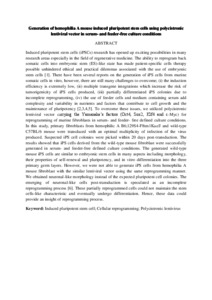Citation
M. Sakri, Rozita and Abdullah, Syahril and Mohamed Said, Mohamed Saifulaman
(2016)
Generation of hemophilia A mouse induced pluripotent stem cells using polycistronic lentiviral vector in serum- and feeder-free culture conditions.
In: 6th Malaysian Tissue Engineering and Regenerative Medicine Scientific Meeting (6th MTERMS) 2016 and 2nd Malaysian Stem Cell Meeting, Seberang Jaya, Penang, Malaysia, 17 - 18 Nov, 2016. .
Abstract
Induced pluripotent stem cells (iPSCs) research has opened up exciting possibilities in many research areas especially in the field of regenerative medicine. The ability to reprogram back somatic cells into embryonic stem (ES)-like state has made patient-specific cells therapy possible unhindered ethical and practical dilemmas associated with the use of embryonic stem cells [1]. There have been several reports on the generation of iPS cells from murine somatic cells in vitro, however, there are still many challenges to overcome; (i) the induction efficiency is extremely low, (ii) multiple transgene integrations which increase the risk of tumorigenicity of iPS cells produced, (iii) partially differentiated iPS colonies due to incomplete reprogramming, (iv) the use of feeder cells and medium containing serum add complexity and variability in nutrients and factors that contribute to cell growth and the maintenance of pluripotency [2,3,4,5]. To overcome these issues, we utilized polycistronic lentiviral vector carrying the Yamanaka’s factors (Oct4, Sox2, Klf4 and c-Myc) for reprogramming of murine fibroblasts in serum- and feeder- free defined culture conditions.
In this study, primary fibroblasts from hemophilic A B6;129S4-F8tm1Kaz/J and wild-type C57BL/6 mouse were transduced with an optimal multiplicity of infection of the virus produced. Suspected iPS cell colonies were picked within 20 days post-transduction. The results showed that iPS cells derived from the wild-type mouse fibroblast were successfully generated in serum- and feeder-free defined culture conditions. The generated wild-type mouse iPS cells are similar to embryonic stem cells in many aspects including morphology, their properties of self-renewal and pluripotency, and in vitro differentiation into the three primary germ layers. However, we were not able to generate iPS cells from hemophilia A mouse fibroblast with the similar lentiviral vector using the same reprogramming manner. We obtained neuronal-like morphology instead of the expected pluripotent cell colonies. The emerging of neuronal-like cells post-transduction is speculated as an incomplete reprogramming process [6]. These partially reprogrammed cells could not maintain the stem cells-like characteristic and eventually undergo differentiation. Hence, these data could provide an insight of reprogramming process.
Download File
![[img]](http://psasir.upm.edu.my/54023/1.hassmallThumbnailVersion/Generation%20of%20hemophilia%20A%20mouse%20induced%20pluripotent%20stem%20cells%20using%20polycistronic%20lentiviral%20vector%20in%20serum-%20and%20feeder-free%20culture%20conditions.pdf)  Preview |
|
Text
Generation of hemophilia A mouse induced pluripotent stem cells using polycistronic lentiviral vector in serum- and feeder-free culture conditions.pdf
Download (154kB)
| Preview
|
|
Additional Metadata
Actions (login required)
 |
View Item |

